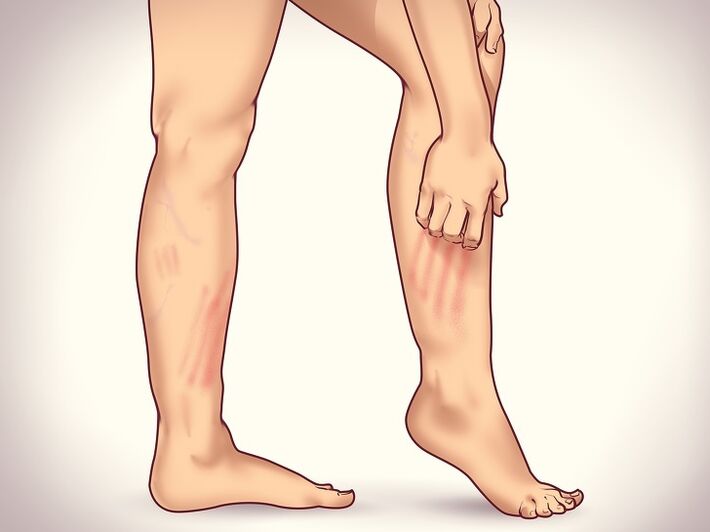At the mention of varicose veins, many people imagine ugly knots that perform on the legs.However, in addition to external problems, varicose veins can lead to more serious complications up to the loss of mobility.According to statistics, 30 % of women and at least 10 % of men treat this disorder for medical assistance.Therefore, it is so important to know the first completely not obvious signs of an initial disease in order to start treatment in time and avoid unpleasant consequences.

Itching in legs and ankles
One of the most irust and often ignored symptoms of varicose veins is itching in legs and ankles.It is due to the changes that occur in ships and fabrics adjacent to the focus.Blood stagnation in affected veins causes a violation of tissue nutrition: metabolic products cease to be expelled correctly.It is this process that is the cause of excessive dryness and peeling of the skin of the legs.
The itching for varicose veins seems to be a rather "safe" symptom, but it is that it reports the beginning of the disease.In the future, it can lead to the formation of trophic ulcers.
What the doctor will do:
It will prescribe antihistamines that reduce the swelling of the tissues and relieve the spasms that interfere with the normal movement of blood and life.
It will prescribe sedatives that will calm the nervous system and normalize sleep.
Recommends antibacterial ointments and cure creams that will not allow infections and hydrate the skin.
Muscle cramps
The varicose veins of the lower ends occur in a variety of symptoms, but the most famous night convulsions in the legs.Due to blood stagnation, there is a violation of circulation in the smaller veins and vessels.In turn, the pressure on adjacent tissues grows, the nerve endings are irritated and, consequently, cramps.In addition, the muscles, due to the bad metabolism, begin to experience oxygen hunger, which also leads to convulsions.
Changing the color of the skin
Quite often, patients with varicose veins complain of changing the color of the skin in the area of deeply affected veins.The irregular color of the legs - white or, on the contrary, dark spots - should notify those who suspect the presence of varicose veins.
The change of color is due to the lack of blood supply and poor lymphatic circulation.Initially, the points do not worry in any way, but as the disease develops, the situation becomes alarming: it appears to be roasted, compact, itching.In this case, doctors warn the patient on the possibility of inflammation and even the appearance of trophic ulcers, but only in the absence of treatment.
Pain that intensifies after periods of immobility
If, after long periods of immobility and remain in a static position, the legs begin to hurt, this is an opportunity to look closely at their health.In the initial stages of the varicose veins, the pain is almost invisible, passes if you raise your legs higher or make a light massage.Despite low intensity, this pain is an alarming symptom.The unpleasant sensations in the legs are associated with poor blood circulation: in a healthy body, the blood quickly makes the path from the legs to the heart, but the varicose veins prevent this process.
Flebology states that varicose veins are associated with heart health.And it is recommended to examine the cardiovascular system for problems with the veins to be examined in order to avoid problems with the cardiac valves.
Numbness and tingling
The short -term periodic innerplacement of the feet can indicate the initial stage of the varicose veins.If it is rare, then it is not an alarming sign of the disease: it is a physiological rule.But the repeated episodes indicate the need to visit a phlebologist.
I numbness is a rather complicated process.Its presence is due to the weak function of the joints.And the weak functioning of the joints occurs due to an insufficient supply of oxygen tissues.The limbs do not have quite liquid among the joints responsible for normal motor activity.
Doctors warn the danger of numbness and, if persistent symptoms occur, they recommend asking for qualified help.
Swelling
Often swelling are the precursors of varicose veins.The swelling of the tissues is due to the accumulation of fluid in the intercellular space.This happens if the venous valves work incorrectly.Generally, varicose edema appears in the evening and intensifies with the heat.To determine the deviations, the doctors recommend measuring the circumference of an ankle: if in the evening it is more than the morning of 1 cm, therefore, most likely, it is time to play the alarm.According to statistics and swelling of the legs, women are more affected.
How to prevent the appearance of varicose veins
- Move actively every day.A correct blood circulation and, therefore, the health of the veins depends directly on physical activity.
- Aeronautical flights lasting over 4 hours increase the risk of stagnation and even the formation of deep vein thrombosis.During the flight, drink water, remove your shoes, don't wear tight clothes.All this complicates the flow of blood to the peripheral vessels.
- Wear compression linen.The compression knitwear is the most convenient way to prevent varicose veins.With correct use, it prevents the appearance of "stars" and edema.
- He begins to conduct a healthy lifestyle.Excess weight, smoke and fatty foods are the main enemies of beautiful legs.
- Drink at least 1.5 liters of liquid per day.When dehydration, the blood thickens and the veins move it with difficulty.
- Look how you are sitting.The laying of the "leg on the leg" complicates correct blood circulation.
- The best types of physical activity for the prevention of varicose veins: walking (also on the stairs of the office building), lengthening, running and yoga.


















